#HubSpot for Startup
Explore tagged Tumblr posts
Text
Why You Need an Inbound Marketing Agency to Thrive in Today's Digital Landscape

The digital marketing landscape is constantly evolving. Traditional outbound marketing tactics, like intrusive cold calls and generic email blasts, are becoming increasingly ineffective. Consumers today are bombarded with marketing messages, making it crucial to stand out from the noise and create genuine connections. This is where inbound marketing comes in, and an inbound marketing agency can be your secret weapon.
What is Inbound Marketing?
Inbound marketing focuses on attracting, engaging, and delighting customers through valuable content and experiences. It’s a customer-centric approach that aims to build trust and brand loyalty over time, leading to sustainable business growth.
Why You Need an Inbound Marketing Agency.
While the principles of inbound marketing are straightforward, implementing it effectively can be complex. Here’s where an inbound marketing agency comes in. They offer a unique set of benefits that can help your business thrive:
1. Expertise and Resources: An inbound marketing agency brings a wealth of knowledge and experience to the table. They have a team of skilled professionals well-versed in various inbound marketing tools, SaaS automation, SEO, content marketing, social media marketing, and email marketing. This expertise allows them to develop and execute a comprehensive inbound marketing strategy tailored to your specific business goals and target audience.
2. Time-Saving Efficiency: Managing all aspects of inbound marketing in-house can be a significant time commitment, especially for small size businesses and medium-sized businesses. An inbound marketing agency takes this burden off your shoulders, freeing up your team to focus on core business operations. They can handle everything from content creation and social media management to email marketing automation and campaign analytics.
3. Strategic Planning and Execution: Developing a successful inbound marketing strategy requires a clear understanding of your target audience, their needs, and the buyer’s journey. An inbound marketing agency will conduct thorough research and analysis to develop data-driven strategies that attract qualified leads and convert them into customers. They will also stay up-to-date on the latest industry trends and adapt your strategy accordingly.
4. Cost-Effectiveness: Building an in-house inbound marketing team can be expensive, requiring salaries, benefits, and the cost of marketing tools. An inbound marketing agency offers a more cost-effective solution. You only pay for the services you need, and you gain access to a team of experts without the overhead costs of hiring full-time employees.

What Services Do Inbound Marketing Agencies Offer?
Inbound marketing agencies offer a wide range of services to help you achieve your marketing goals. Here are some of the key services you can expect:
1. Inbound Marketing Strategy Development: An inbound marketing agency will work with you to develop a comprehensive inbound marketing strategy aligned with your overall business objectives. This strategy will identify your target audience, define your buyer personas, and outline the tactics you will use to attract, engage, and convert leads.
2. Content Marketing: Creating high-quality, valuable content is essential for inbound marketing success. An inbound marketing agency can help you develop a content calendar, create blog posts, infographics, videos, and other engaging content formats to attract visitors to your website and establish your brand as a thought leader in your industry.
3. Search Engine Optimization (SEO): Improving your website’s ranking in search engine results pages (SERPs) is crucial for driving organic traffic. An inbound marketing agency can optimize your website content and technical aspects for search engines, ensuring your target audience can easily find you online.
4. Social Media Marketing: Social media platforms provide a powerful avenue to connect with your target audience and build brand awareness. An inbound marketing agency can develop and manage your social media presence, creating engaging content, scheduling posts, and interacting with followers.
5. Email Marketing: Email marketing remains a highly effective marketing tool. An inbound marketing agency can help you create targeted email campaigns to nurture leads, promote offers, and build customer loyalty.
6. Marketing Automation: SaaS automation tools can streamline your marketing efforts and improve efficiency. An inbound marketing agency can help you implement marketing automation tools to automate repetitive tasks such as email marketing campaigns and lead nurturing sequences.
7. Lead Generation and Lead Nurturing: Generating qualified leads is essential for any business. An inbound marketing agency can develop effective lead generation strategies and implement lead nurturing campaigns to convert leads into customers.
8. Analytics and Reporting: Tracking the performance of your inbound marketing efforts is crucial for measuring success and making adjustments as needed.
Conclusion
In today’s competitive digital landscape, a strategic inbound marketing approach is essential for business growth. Partnering with an inbound marketing agency can empower your business to achieve its marketing goals. They offer a wealth of expertise, resources, and time-saving efficiencies to develop and execute a data-driven inbound marketing strategy that attracts qualified leads, nurtures them into customers, and drives sustainable business success.
#inbound marketing tools#inboundmarketing#hubspot agency#hubspotcrm#hubspotcommerce#hubspot cms#hubspot starter#HubSpot for Startup#HubSpot Marketing#HubSpot Agency in Cincinnati#marketing agency in cincinnati#hubspot#Inbound Marketing Agency
0 notes
Text

Say goodbye to messy spreadsheets and missed follow-ups! Use a free CRM tool to manage contacts, leads, sales, and tasks in one simple dashboard. Ideal for small businesses, freelancers, and home-based startups. Enjoy features like email integration, sales tracking, reporting, and team collaboration. Leading options include HubSpot CRM, Agile CRM, and Zoho—all offering robust free plans.
🛠️ It’s time to work smarter—Get your free CRM and start scaling today!
#Free CRM#CRM for small business#CRM software#customer relationship management#small business tools#startup CRM#HubSpot CRM#Zoho CRM#Bitrix24#Freshsales CRM#lead tracking#contact management#sales automation#CRM India#best free CRM#CRM for startups#business productivity tools#CRM apps#CRM tools for freelancers#CRM for service provi
0 notes
Text
My Editorial Review of the Smart Email Marketing Book
Email Marketing Was Rocket Science to Me Until I Read this SMART Book by my distinguished mentor, Dr Mehmet Yildiz. Over eight months ago, I was fortunate enough to receive early access to the original manuscript of this book. At that time, it was over a thousand pages — a vast, rich body of knowledge that could have easily become overwhelming. But as a line editor and alpha reader, my role was…
#Be a beta reader of Smart Email Marketing#Dr Mike Broadly reviewed Smart Email marketing#editorial review of smart emal marketing book#Editorial Review of Substack Mastery by Dr Mehmet Yildiz#email marketing and content integration#Email marketing best practices#Email marketing case studies#email marketing demystified#email marketing for academics#email marketing for artists#email marketing for Beehiive writers#Email Marketing for Beginners#email marketing for bestselling books#email marketing for bestselling substack newsletters#email marketing for business growth#email marketing for convertkit writers#Email Marketing for Creators#email marketing for entrpreneurs#email marketing for freelance writers#email marketing for freelancers#email marketing for ghost writers#email marketing for HubSpot#email marketing for mailchimp writers#email marketing for marketers#email marketing for professionals#email marketing for public health#email marketing for researchers#email marketing for scientists#email marketing for small businss#email marketing for startups
0 notes
Text
Master Digital Marketing Without an MBA
🚀 Ready to conquer the digital marketing world, one campaign at a time! From mastering Google Skillshop to crafting creative strategies for startups, I’m diving deep into the art and science of marketing. Follow along as I share tips, tools, and my journ
So, here I am. Sitting at my desk, armed with a laptop and a double shot of self-doubt. I want to conquer the digital marketing world, but there’s this nagging voice in my head: “You’re not an MBA. Who are you kidding?” Sound familiar? Great, then you’re in the right place. Let’s get one thing straight: MBAs are cool. But so are self-taught, scrappy, AI-savvy folks like us. Here’s the game…
#AI in marketing#analytics and reporting#beginner&039;s guide to digital marketing#consistent learning#content marketing#CRM tools#data-driven campaigns#digital marketing#digital marketing portfolio#digital marketing roadmap#e-commerce campaigns#EdTech marketing#Google Skillshop#HubSpot Academy#influencer marketing#LinkedIn networking#marketing strategies#Meta Blueprint#personal branding#self-taught marketing#SEO basics#small business SEO#social media marketing#startup marketing
0 notes
Text
LeadsMate AI by Firas and Rahul Review
LeadsMate AI by Firas and Rahul – Enhance Your Lead Generation Efforts with AI Insights and Automation for Higher Conversions Using LeadsMate AI LeadsMate AI by Firas and Rahul is quickly becoming an indispensable tool for businesses aiming to modernize their lead generation process. Powered by state-of-the-art AI, it pulls data from a variety of sources, such as Google, LinkedIn, Facebook Meta,…
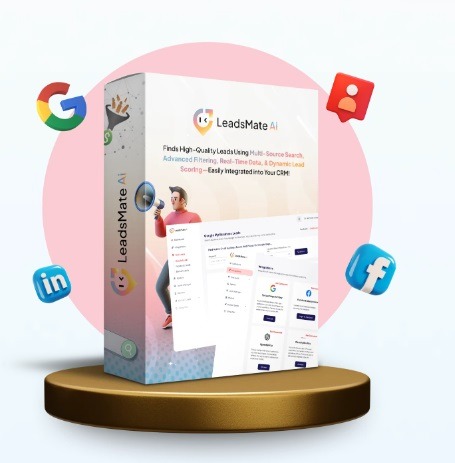
View On WordPress
#Best practices for using LeadsMate#How to use LeadsMate to generate more sales leads#Is LeadsMate worth it for real estate agents?#LeadsMate alternatives for startups#LeadsMate customer service review#LeadsMate integration with HubSpot#LeadsMate pricing plans and features#LeadsMate review for small businesses#LeadsMate tutorial for beginners#LeadsMate vs Zoho CRM: A detailed comparison
0 notes
Text
HubSpot Apoya a Startups en Chile con Bootstrap LATAM
Las startups de Chile y Latinoamérica podrán impulsar sus iniciativas con una completa suite digital con grandes descuentos y beneficios, ya que HubSpot lanzó “Bootstrap LATAM”, un programa inédito diseñado para ofrecer una oferta excepcional a los fundadores de empresas tecnológicas B2B y B2C. La iniciativa de HubSpot pone al alcance de los emprendedores herramientas de última generación a…
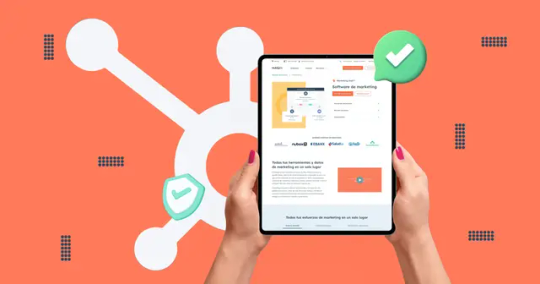
View On WordPress
0 notes
Text
📝😫 This is how working on document validation can be, without Accessque. 😩 So, check us out and book a demo now and experience the change yourself. 💻🔍✨ Book a demo: https://www.accessque.co.uk/book-demo
#crm#universities#recruiters#studyabroad#aidocumentvalidation#transcriptadmissionsprocess#educationtechnology#admission#datasecurity#automatedverification#Alumni#crmsoftware#zoho#salesforce#hubspot#freshsales#nutshell#digitalmarketing#entrepreneurship#startups#socialnetworking#datadriven
0 notes
Text
Scope of Digital Marketing in the Present Industry
Digital marketing has become one of the most in-demand and fastest-growing career fields in the modern business world. With rapid digitalization, almost every business—from small startups to large multinational companies—is shifting towards online marketing.
📌 Key Areas Showing the Scope of Digital Marketing:
Increasing Internet and Mobile Users
As of 2025, there are over 5 billion internet users globally.
Rising smartphone usage means people spend more time online, creating more opportunities for digital marketers.
High Demand for Digital Marketing Professionals
Businesses need SEO experts, Content Marketers, Social Media Managers, Google Ads specialists, and Digital Analytics professionals.
Job roles in digital marketing are increasing across industries like e-commerce, education, real estate, healthcare, finance, etc.
Cost-Effective Marketing Compared to Traditional Marketing
Digital marketing offers lower costs and better targeting than TV, radio, or print ads.
Small businesses and startups prefer digital channels like Google Ads, Facebook Ads, and Email Marketing for budget-friendly promotion.
Rise of E-commerce and Online Shopping
Online shopping platforms like Amazon, Flipkart, and Myntra are driving demand for Performance Marketing, SEO, Affiliate Marketing, and Influencer Collaborations.
Growing Importance of Social Media Marketing
Platforms like Instagram, Facebook, LinkedIn, YouTube, and Twitter are being widely used by businesses for brand awareness, lead generation, and engagement.
Social media influencer marketing is also booming.
Data-Driven Marketing and Analytics
Companies are using tools like Google Analytics, Google Tag Manager, Hotjar, and Facebook Pixel to track and analyze customer behavior.
Performance tracking and ROI measurement are key focuses.
Career Opportunities in Freelancing and Remote Jobs
Many businesses are outsourcing their digital marketing work.
There’s a high demand for freelancers skilled in content writing, SEO, PPC, and graphic design.
Emerging Technologies in Digital Marketing
Use of AI in ads targeting, chatbots, programmatic advertising, voice search optimization, and video marketing is growing rapidly.
Scope in Global Markets
With digital marketing skills, professionals can work for international clients sitting from anywhere (remote work, freelancing platforms like Upwork, Fiverr).
Growth in Education and Training Sector
High demand for digital marketing courses, certifications, and online training programs like Google Digital Garage, HubSpot Academy, Coursera, etc.
2 notes
·
View notes
Text
Starting Salary in Digital Marketing: A Complete Guide for Freshers
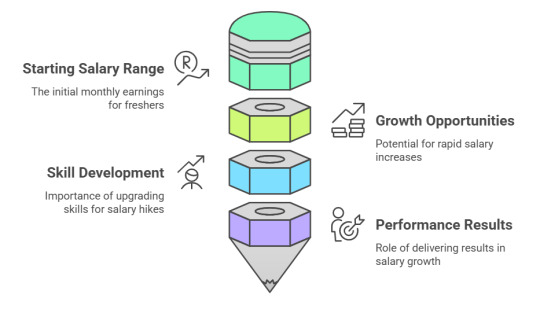
Introduction
If you're considering a career in digital marketing, one of the first things you might wonder about is the starting salary in digital marketing. Whether you're a fresh graduate or someone switching careers, understanding the financial prospects of the field is crucial. In this blog, we will discuss the starting salary in digital marketing, factors affecting salaries, different roles, and tips to increase your earnings.
What is the Starting Salary in Digital Marketing?
The starting salary in digital marketing varies based on multiple factors such as location, skills, company size, and experience level. On average, freshers in digital marketing can expect to earn anywhere between $30,000 to $50,000 per year in the United States. In India, the starting salary in digital marketing typically ranges from ₹2.5 LPA to ₹4.5 LPA.
Factors Affecting Starting Salary in Digital Marketing
1. Location
The starting salary in digital marketing significantly differs from country to country and even within different cities. Metropolitan areas often offer higher salaries due to increased demand and cost of living.
2. Skills and Certifications
If you have certifications from platforms like Google, HubSpot, or Facebook, you can negotiate a better starting salary in digital marketing. Specialized skills like SEO, PPC, and social media marketing can give you an edge.
3. Company Size and Type
MNCs and established agencies tend to offer a higher starting salary in digital marketingthan startups. However, startups can provide faster growth opportunities and hands-on experience.
4. Job Role and Responsibilities
Different roles within digital marketing have different salary structures. A content writer might earn less than a PPC specialist, while an SEO analyst may have a different pay scale than a social media manager.
Common Digital Marketing Roles and Their Salaries
Here are some of the most common roles in digital marketing and their respective starting salary in digital marketing:
1. SEO Executive
USA: $35,000 - $50,000 per year
India: ₹2.5 LPA - ₹4 LPA
2. Content Writer
USA: $30,000 - $45,000 per year
India: ₹2 LPA - ₹3.5 LPA
3. Social Media Manager
USA: $40,000 - $55,000 per year
India: ₹3 LPA - ₹5 LPA
4. PPC Specialist
USA: $45,000 - $60,000 per year
India: ₹3.5 LPA - ₹6 LPA
5. Email Marketing Executive
USA: $35,000 - $50,000 per year
India: ₹2.5 LPA - ₹4.5 LPA
6. Affiliate Marketer
USA: $40,000 - $55,000 per year
India: ₹3 LPA - ₹5 LPA
How to Increase Your Starting Salary in Digital Marketing
Here are some tips to boost your starting salary in digital marketing:
1. Get Certified
Earning certifications from Google Ads, HubSpot, Facebook, and other platforms can increase your earning potential.
2. Build a Portfolio
Having a strong portfolio with real-world projects showcases your skills and makes you a desirable candidate.
3. Gain Experience Through Internships
Internships help you gain hands-on experience and can significantly impact your starting salary in digital marketing.
4. Learn Advanced Skills
Mastering skills like paid advertising (Google Ads, Facebook Ads), data analytics, and email automation can set you apart.
5. Network with Industry Experts
Attending webinars, networking events, and joining LinkedIn groups can open doors to better-paying opportunities.
Future Growth in Digital Marketing Salaries
The demand for digital marketers is increasing rapidly. As businesses continue shifting to online platforms, the scope and starting salary in digital marketing will keep rising. Within 2-3 years, you can expect significant salary hikes, with experienced professionals earning over $70,000 per year in the US and ₹10 LPA+ in India.
Conclusion
Thestarting salary in digital marketingdepends on several factors like location, skills, job role, and company type. By upskilling, gaining experience, and networking, you can increase your earning potential and build a successful career in digital marketing.
2 notes
·
View notes
Text
How to Win Big with B2B Lead Generation in India - A Practical Guide
If you're running a business in India and looking to grow, one thing is clear getting high quality B2B leads isn’t just helpful, it’s essential. Whether you're a startup trying to land your first few clients or a mid sized company ready to scale, B2B lead generation in India can make all the difference between hitting your targets or falling short.
But here’s the catch the Indian market is unique. It’s a vibrant mix of traditional business values and modern digital tools. And to really succeed here, your lead generation strategy needs to reflect that.
What Makes B2B Lead Generation in India Different?
Doing business in India isn’t just about numbers it’s about relationships. Unlike many Western markets where decision making is fast and data driven, Indian businesses often take time, involve multiple stakeholders, and value trust above all.
Add in the language diversity, regional preferences, and varying levels of digital adoption, and it becomes clear why a one size fits all approach just doesn’t work here.
So, What Actually Works?
Here are some tried and tested methods that businesses are using right now to generate solid B2B leads in India:
Speak their language literally and culturally. Whether it's your website content or sales emails, making sure your message resonates with Indian businesses goes a long way. Use clear, respectful language and show that you understand the challenges your audience faces.
Leverage LinkedIn smartly. LinkedIn is where a lot of decision makers in India hang out. Sending out tailored messages (not spammy ones) and sharing helpful content regularly can slowly build the right connections.
Email isn’t dead just needs a personal touch. If you’re sending cold emails, make sure they’re not generic. Indian professionals appreciate personalized outreach that clearly shows you’ve done your homework.
Don’t ignore SEO. Ranking for keywords like B2B lead generation in India can bring in leads passively over time. It’s a slow burn, but it’s worth the effort.
Build trust through content. Share success stories, case studies, and testimonials. Indian buyers often rely on word of mouth or social proof before making a decision.
Challenges to Be Aware Of
Let’s be real B2B lead generation in India isn’t always smooth sailing. You’ll likely face:
Long decision making cycles with multiple layers of approvals.
Price sensitivity, especially in smaller cities or among SMEs.
Skepticism toward new vendors unless backed by solid proof.
But don’t let that discourage you. Once you break through those initial barriers, Indian clients often become long term partners.
Tools That Can Help
You don’t have to do it all manually. A few tools can really boost your efficiency:
CRM tools like Zoho or HubSpot to keep track of every lead.
Email automation tools like Mailchimp to nurture contacts over time.
Analytics tools to see what’s working and what’s not.
Conclusion
If you’re serious about growing in this market, investing in B2B lead generation in India is one of the smartest moves you can make. And if you’re looking for a trusted partner to help you do it right, Demand Fluence is the go to name. They understand the Indian B2B space inside out and bring the right mix of strategy, technology, and human touch to get you results.
At the end of the day, B2B success in India comes down to understanding people, being consistent, and building real connections. Start there, and your leads and business will follow.
#b2b lead generation company in india#B2b Lead Generation Companies In Pune#B2b Lead Gen Companies#B2b Lead Generation In India#b2b lead generation services
1 note
·
View note
Text
Growing Your Ohio Startup: A Guide to HubSpot for Startups and Early-Stage Businesses
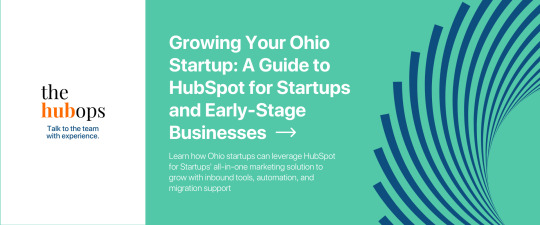
The startup scene in Ohio is thriving, with innovative businesses emerging across various industries. But for early-stage companies, navigating the complexities of marketing can be a challenge. Fortunately, there’s a solution: HubSpot for Startups. This program offers a powerful all-in-one marketing solution specifically designed to empower young businesses with the tools they need to grow.
Why HubSpot for Startups is Ideal for Ohio’s Rising Stars
Ohio startups face unique challenges. Limited resources, tight budgets, and a need for rapid growth are all common hurdles. Here’s how HubSpot for Startups addresses these concerns:
Cost-Effectiveness: HubSpot for Startups offers significant discounts on HubSpot’s professional marketing tools, making it an attractive option for budget-conscious businesses. Depending on your funding stage, you can qualify for discounts of up to 75% in your first year, significantly reducing your marketing software expenses.
All-in-One Solution: HubSpot for Startups goes beyond just email marketing or social media management. It provides a comprehensive suite of tools for inbound marketing, including CRM (Customer Relationship Management), marketing automation, content management, and analytics. This eliminates the need for multiple software subscriptions, simplifying your tech stack and streamlining your marketing efforts.
Growth-Focused Tools: The platform equips you with tools specifically designed to attract leads, nurture relationships, and convert them into loyal customers. Features like landing page builders, email automation workflows, and lead scoring help you capture leads efficiently and nurture them through the sales funnel.
Scalability: As your Ohio startup grows, HubSpot for Startups scales with you. You can upgrade your plan to access more advanced features and capabilities without needing to switch platforms.
Ease of Use: HubSpot’s user-friendly interface makes it easy for even non-technical teams to get started. The platform offers extensive training resources and a supportive community to ensure you maximize the value of your subscription.
Key Features of HubSpot for Startups for Ohio Businesses
HubSpot for Startups equips your Ohio business with a powerful arsenal of tools:
CRM: Manage your customer relationships effectively with a centralized platform for storing contact information, tracking interactions, and nurturing leads.
Marketing Automation: Automate repetitive tasks like email marketing, social media posting, and lead nurturing campaigns, freeing up your team’s time to focus on strategic initiatives.
Content Management System (CMS): Create and publish compelling content on your website using HubSpot’s user-friendly CMS. Optimize your website for search engines and manage your blog seamlessly.
Landing Page Builder: Design high-converting landing pages to capture leads and generate sales. No coding knowledge is required.
Analytics & Reporting: Gain valuable insights into your marketing performance with comprehensive reports and analytics. Track key metrics, identify areas for improvement, and measure the ROI of your campaigns.
Email Marketing: Create and send targeted email campaigns to nurture leads and engage with customers.

Migrating from WordPress to HubSpot
If your Ohio startup is currently using WordPress for your website, you’re not alone. Many businesses start with WordPress due to its ease of use. However, as your needs evolve, HubSpot offers a powerful alternative. Here’s how HubSpot for Startups can help you migrate:
Simplified Migration: HubSpot offers tools and resources to make migrating your website content and data from WordPress to HubSpot CMS a smooth process.
Enhanced Functionality: HubSpot CMS goes beyond basic content management, offering built-in marketing and SEO features that streamline your workflow and improve lead generation.
All-in-One Platform: Consolidate your website management, marketing tools, and CRM into a single platform for improved efficiency and better data insights.
Beyond the Software: Resources and Support for Ohio Startups
HubSpot for Startups goes beyond providing software. It offers valuable resources and support to help your Ohio startup succeed:
Free Online Courses: Access a library of free online courses and certifications to learn inbound marketing best practices and master HubSpot tools.
Startup Community: Connect and network with other early-stage businesses through the HubSpot for Startups community. Share experiences, ask questions, and learn from each other’s successes.
Startup Onboarding Specialists: Get personalized onboarding help from HubSpot’s dedicated Startup Onboarding Specialists to ensure you get the most out of the platform.
Taking Your Ohio Startup to the Next Level with HubSpot
HubSpot for Startups is a game-changer for Ohio’s early-stage businesses. By leveraging its powerful all-in-one marketing solution, you can attract leads, make more conversions and scale your business for better growth.
#hubspot agency cincinnati#HubSpot for Startups#hubspotcms#webdevelopment#digitalmarketing#Cleveland social media advertising#Cleveland social media marketing#hubspot agency Cincinnati#web page design for life science#bespoke cms solutions#crm consulting Cincinnati#cms customization services#marketing agency akron ohio#seo marketing agency ohio#marketing agencies cincinnati ohio
0 notes
Text

A CRM is a powerful tool that can help your small business grow smarter and faster by improving customer relationships, sales tracking, and marketing efforts. The best CRM for your business depends on your specific needs, budget, and technical comfort.
Start by trying out free options like HubSpot CRM, then explore paid tools like Zoho CRM or Salesforce Essentials if you need more advanced features. The right CRM will help you stay organized, boost sales, and deliver better service — the keys to thriving in a competitive market.
#best CRM for small business#small business CRM software#CRM tools for small business#affordable CRM#CRM comparison#HubSpot CRM review#Zoho CRM features#Salesforce Essentials#Pipedrive CRM#Freshsales CRM#CRM automation#sales pipeline management#customer relationship management#CRM for startups#CRM software 2025#CRM integration#easy to use CRM#CRM pricing#CRM for small teams#CRM benefits
1 note
·
View note
Text
Why Email Marketing Is the Best Tool for Startups and Freelancers
Business Education for Startups and Freelancers Email Marketing is a Proven Tool Used by Respected Professionals and Businesses to Build Meaningful Connections Ethical and Smart Email Marketing Is What I Endorse When some people in my circle hear “email marketing,” they immediately think of it as spam — unwanted messages flooding inboxes, shady sales tactics, or relentless promotions that push…
#cold email marketing techniques#earning income with email marketing#email marketing#email marketing and content integration#Email marketing best practices#Email marketing case studies#email marketing demystified#email marketing for Beehiive writers#Email Marketing for Beginners#email marketing for convertkit writers#Email Marketing for Creators#email marketing for entrpreneurs#email marketing for freelance writers#email marketing for ghost writers#email marketing for HubSpot#email marketing for mailchimp writers#email marketing for professionals#email marketing for small businss#email marketing for startups#email marketing for substack writers#email marketing inventions#email marketing leadership#Email marketing pitfalls#Email Marketing Platforms#email marketing secrets#email marketing strategies#Email marketing success stories#email marketing tactics#email marketing techniques#history of email marketing
0 notes
Text

Most companies treat video like a campaign asset. You need a video. You hire a vendor. They shoot something nice. You post it to your website or maybe Instagram. Done. On to the next thing.
Might have been okay in 2018, but that’s not how smart brands are thinking anymore.
Smart brands know that video isn’t just for one channel or one moment. And it’s not just a tool…it’s the face, tone, and heartbeat of your brand. And in a world where your audience is scattered across Instagram, LinkedIn, YouTube, TikTok, and internal Slack threads (yes, even those), how you show up needs to be thoughtful. Consistent. Purpose-built.
We’ve seen what happens when teams stop treating video like a box to check and start thinking about it as a system of interconnected opportunities.
The trend these days, from all kinds of industries (healthcare systems, tech startups, nonprofits, and product-driven brands) is to turn a single video day into weeks of content. This video content is planned in such a way that it spans the channels: social, sales, recruiting, internal comms…etc. And we’re not talking about repurposing in a sloppy, “just crop it for vertical” way. We mean crafting smart, multi-platform assets that feel like they were made just for that channel.
Why does it matter? Because attention is fragmented, but expectations are high. According to HubSpot’s 2023 State of Marketing Report, 91% of marketers say video has helped increase traffic and user understanding. But that’s only if the video gets seen (and feels relevant) where it shows up.
So this article is for the brand managers, creative directors, and small-but-mighty marketing leads who are trying to make their video investment work harder. You’ve got a team, you’ve got a budget, but maybe not the time or resources to shoot something new for every platform. You don’t need more content—you need a better strategy for stretching it.
Here are five (okay, six) ways the smartest brands are working with a video company to show up with purpose…everywhere their audience is watching.
1. Creating Once, Publishing Everywhere (Without Losing Quality)
You don’t need five shoot days to get five pieces of content. But you do need a plan.
Too many marketing teams approach video with a single deliverable in mind: “We need a brand video” or “Let’s film something for the website.” Totally fair. But what gets missed is how much more you can pull from the same shoot—if you plan for it from the start.
At Awakened Films, we talk about this a lot in pre-production. We ask: “Where else will this content live?” Because the raw footage you’re about to create can stretch across your site, social feeds, sales decks, email campaigns, even internal channels—if it’s captured with those use cases in mind.

But let’s be clear: this isn’t about dumping the same 90-second edit on every platform. A good video company builds with channels in mind. YouTube? Needs a longer arc. Instagram? Faster pacing, punchier visuals. LinkedIn? Add subtitles, lead with clarity. TikTok? You’re lucky if you have two seconds—so your first frame better pop.
This stuff matters. According to Wipster, approximately 20% of viewers drop off in the first 10 seconds of a video.
And SuperReel reports that 33% of viewers will stop watching a video after 30 seconds, 45% by one minute, and 60% by two minutes.
We all know that 3 seconds are considered a ‘view’ by facebook. And these are not things that you fix in post…it’s something you plan for before you ever hit record.
And no, you don’t necessarily need to produce 10 separate videos from scratch. You just need to produce smartly and with a creative team who knows how to stretch it across every touchpoint without losing your voice.
2. Making Brand Messaging Stick Through Visual Consistency
Most companies have a brand guide. Fonts, colors, logo lockups. Maybe even some tone-of-voice guidelines tucked away in a Google Drive folder that hasn’t been touched in a while. But here’s the thing: none of that matters if your video content doesn’t reflect it. Video is often the first time someone feels your brand. It’s tone of voice, music choice, pacing, color grade, animation style. All of that is doing heavy lifting—even when you don’t call attention to it.
At Awakened Films, we’ve been contacted by brands that had buttoned-up style guides and still ended up with commercial video content from a previous vendor that didn’t quite feel choesive. Why? Because the previous vendor that made the video never saw the bigger picture. They were handed a script, told to “make it look good,” and left to interpret the brand on their own.
That’s a missed opportunity.
Your video company should function like an extension of your brand team (not just a crew with cameras). They should be asking questions like:“What’s the emotional tone here?”“Is this music too aggressive for our audience?”“Would these types of customers expect this level of polish, or something more raw and direct?”
This level of visual consistency isn’t about being fancy—it’s about being recognizable. According to a report by Marq, brands with consistent presentation across platforms can increase revenue by up to 23%. That’s not fluff. That’s real lift, driven by familiarity and trust.
One of our nonprofit clients had three very different initiatives under the same umbrella: community outreach, education & fundraising. Instead of creating three completely separate visual identities, we built a shared video system: consistent colors, lower thirds, motion graphic elements, and even a recurring intro sting. Each video felt unique, but they all clearly belonged to the same family. It gave their scattered channels a sense of cohesion and made it easier for their audience to follow along, no matter where they interacted with the brand.
The bottom line is that you want someone to see your video mid-scroll, with no sound, and immediately think: That feels right! The correct video partner helps make that happen, not just with a nice final cut, but with design-minded decisions baked into every step of the process.
3. Using A Video Company to Align Internal and External Communication

Here’s the truth: your brand isn’t just what the public sees; it’s what your employees & stakeholders experience. Internally, video helps scale the messages that matter. Culture shifts, executive updates, DEI initiatives, onboarding, training. These are all high-stakes moments where tone, clarity, and empathy matter just as much as they do in a product launch video.
We worked with a regional healthcare provider recently that was rolling out a new patient care model across multiple locations. It wasn’t just a logistics change…it was a whole mindset shift. We created a short, emotionally grounded internal film featuring nurses, staff, and leadership explaining the why behind the change. It didn’t just inform. It helped people feel connected to the mission. And that too is branding (just facing inward).
And there’s a hidden upside: when your internal and external messaging align, everything feels more authentic. If a job candidate watches your recruiting video and then experiences that same energy on day one? That’s powerful. If a sales rep shares a product video that sounds like the CEO’s last town hall? That’s a win.
According to a Gallup study, only 41% of employees strongly agree that they know what their company stands for and what makes it different from competitors. That’s a problem. Video can help close that gap. But only if you’re intentional about using it for both audiences.
So the next time you plan a shoot, ask yourself: “What else could this footage support internally?” A few extra interview questions. A different framing of the story. A quick segment filmed for HR or investor relations. These don’t require a second crew, or even a second shoot day. They just require a little foresight and a video company that sees beyond the campaign.
4. Turning Subject Matter Experts into Scalable Content Engines
There’s a secret stash of content in almost every organization—and it’s not in your Dropbox. It’s sitting in meetings. On Slack threads. Inside your top-performing team members.
We’re talking about your subject matter experts.
Your head of product. The nurse who trains new hires. The founder who can explain your mission in two sentences, better than any copywriter ever could. These people are gold! But only if you know how to capture them in a way that feels real and repeatable.
At Awakened Films, we’ve done a lot of these kinds of interviews. And honestly? Most folks freeze up the second you put a camera in front of them. They default into robot mode or ramble like it’s an unscripted podcast. Neither works. And that’s why a good video company doesn’t just show up and hit record. They research and prepare in advance. They create a safe space. They coach and guide with real-time prompts. And they listen for the stuff that matters…the phrasing, the insight, the story that clicks.

A brand storytelling clip for your homepage
A few punchy thought-leadership videos for LinkedIn
A series of social reels with pull quotes or audio bites
Short-form social proof for recruiting or investor decks
Internal training content for onboarding new hires
And the best part? It doesn’t feel like content. It feels genuine, just like your team. Smart, relatable & human.
One client of ours, a B2B tech firm, used to rely on PDFs to explain their platform. Then we filmed a corporate video with their lead engineer breaking down the product flow in plain English. That segment became their most-clicked landing page video, an asset for onboarding, and a reel for new sales reps. One expert, one hour, weeks of content.
This is how you scale without burning out your marketing team. You don’t need to create new stories from scratch. You just need a partner who knows how to uncover the good ones you already have.
5. Building Evergreen Video Assets That Actually Scale
Most of the videos your team makes will age out fast. Campaigns change. Product features evolve. Logos get refreshed. But a few pieces, if done right, can live on for years. These are your evergreen assets. And they’re some of the most valuable content you can invest in.
We’re talking about things like:
Brand explainers
Product walkthroughs
Customer onboarding
“Why we exist” culture reels
Training or support videos
Testimonials
This kind of content isn’t necessarily the most flashy. But it’s the stuff your team shares over and over again to prospects, new hires, and even existing customers who just need a quick how-to refresher. They save time. They reduce friction. And they help your brand show up without needing to jump on a Zoom call.
One of our clients, a nonprofit focused on mental health, needed a better way to onboard volunteers. Their old process? A binder and a 40-minute Zoom. We worked with them to create a short series of welcoming, heartfelt training videos that covered expectations, safety protocols and the emotional nature of the work. Not only did it save their team hours of repeat explanation, but it also helped new volunteers feel seen and supported before their first day.
These kinds of assets aren’t exciting in the traditional sense. But they pay dividends. According to Vidyard, companies that use video for customer support see a drop in support tickets. That’s real operational efficiency, not just engagement fluff.
The key is to think modular. Build a library (not a one-off). Record a product overview, but also grab the FAQ answers while you’re set up. Film a mission-driven brand story, but also ask for the 30-second version your development team can use in a pitch deck. With the right planning, a single production can give you a shelf’s worth of usable content that doesn’t need to be updated every quarter.
If you’re always chasing the next video but never building foundational ones, you’re missing the kind of content that works for you while you sleep.
6. Testing, Tweaking, and Talking to the Right Audience

It doesn’t mean the video’s bad. Impressions can be a great litmus test for long term ROI. Just because the content didn’t go viral doesn’t mean people didn’t see it. Additionally, perhaps it was just wrong for that channel. Or for that audience. Or maybe even just the way it started.
Here’s the thing a lot of teams miss: one video doesn’t mean one version. The brands that are really winning with video? They’re testing different intros. Trying alternate CTAs. Swapping out the first line of dialogue just to see what holds attention better on YouTube versus LinkedIn. They’re not guessing…they’re gathering data.
Remember that healthcare provider that was rolling out a new patient care model? Instead of one polished piece, we actually built them multiple versions of the same narrative—each with a slightly different opening, call to action, and delivery. One was more emotional. One led with data. One used a patient story. They ran each as an ad to different audience segments. The emotional cut worked better on traditional social and email blasts. The data-driven one performed way better on LinkedIn. Same core message. Very different outcomes.
For our clients with enough budget, that’s the kind of thing we try to bake into projects early. Not just because it’s smart but because in the end, it saves money. If your video company is only delivering one final version, you might just be missing out on all the small optimizations that can drive actual engagement. According to Wistia, companies that A/B test video thumbnails alone see up to 30% more plays. That’s not even changing the content. Just the initial frame. Imagine what happens when you change the hook, the voiceover, or the call to action.
Then there’s the platform piece. TikTok attracts a totally different vibe than LinkedIn. On TikTok, your first line better stop the scroll. On LinkedIn, you need to stay polished and professional. We work with clients to build for those differences from the start, so you’re not just chopping a 16:9 clip into 9:16 and hoping it works.
Want to get the most from your next shoot? Ask for multiple intros. Version your CTAs. Shoot alternate takes. And ask your video company what’s worked for other brands—if they’ve done this before, they’ll know what to look for.
Don’t just publish and hope. Publish, learn, adjust, and repeat. That’s how you turn one great piece of content into a real campaign.
Your Video Company Should Be Thinking Bigger
If your video content isn’t scaling the way it should, let’s talk. We’ve helped brands turn one or two shoot days into full-scale campaigns (without blowing up the budget).
The brands that are making the most of video right now are the ones that are thinking beyond the single edit. They’re planning for platforms. They’re building for scale. And they’re working with partners who understand that video isn’t a one-off…it’s a system. Video content in 2025 is a way to stay visible, consistent, and connected to your audience no matter where they’re watching. It’s not about making more content. It’s about making smarter content, then using it with intention. Across channels. Across teams. Across time.
So next time you begin a video campaign or book a shoot, pause and ask:What else could this do?Where else could this live?Who else needs to see it?
WHAT ELSE CAN WE CAPTURE WHILE WE ARE HERE?
Is your video partner helping you answer those questions?
If not, perhaps there’s a lot of opportunity still sitting on the cutting room floor.
Learn more about our branding work in this case study: https://awakenedfilms.com/case-study/flush-guard-commercial-video-production/
this article was originally published here: https://awakenedfilms.com/how-a-video-company-can-power-your-brand-across-every-channel/
1 note
·
View note
Text
Your Guide to Choosing the Right AI Tools for Small Business Growth
In state-of-the-art speedy-paced international, synthetic intelligence (AI) has come to be a game-changer for businesses of all sizes, mainly small corporations that need to stay aggressive. AI tools are now not constrained to big establishments; less costly and available answers now empower small groups to improve efficiency, decorate patron experience, and boost revenue.
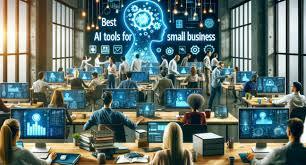
Best AI tools for improving small business customer experience
Here’s a detailed review of the top 10 AI tools that are ideal for small organizations:
1. ChatGPT by using OpenAI
Category: Customer Support & Content Creation
Why It’s Useful:
ChatGPT is an AI-powered conversational assistant designed to help with customer service, content creation, and more. Small companies can use it to generate product descriptions, blog posts, or respond to purchaser inquiries correctly.
Key Features:
24/7 customer service via AI chatbots.
Easy integration into web sites and apps.
Cost-powerful answers for growing enticing content material.
Use Case: A small e-trade commercial enterprise makes use of ChatGPT to handle FAQs and automate patron queries, decreasing the workload on human personnel.
2. Jasper AI
Category: Content Marketing
Why It’s Useful:
Jasper AI specializes in generating first rate marketing content. It’s ideal for creating blogs, social media posts, advert reproduction, and extra, tailored to your emblem’s voice.
Key Features:
AI-powered writing assistance with customizable tones.
Templates for emails, advertisements, and blogs.
Plagiarism detection and search engine optimization optimization.
Use Case: A small enterprise owner uses Jasper AI to create search engine optimization-pleasant blog content material, enhancing their website's visibility and traffic.
Three. HubSpot CRM
Category: Customer Relationship Management
Why It’s Useful:
HubSpot CRM makes use of AI to streamline purchaser relationship control, making it less difficult to music leads, control income pipelines, and improve consumer retention.
Key Features:
Automated lead scoring and observe-ups.
AI insights for customized purchaser interactions.
Seamless integration with advertising gear.
Use Case: A startup leverages HubSpot CRM to automate email follow-ups, increasing conversion costs without hiring extra staff.
Four. Hootsuite Insights Powered by means of Brandwatch
Category: Social Media Management
Why It’s Useful:
Hootsuite integrates AI-powered social media insights to help small businesses tune tendencies, manipulate engagement, and optimize their social media method.
Key Features:
Real-time social listening and analytics.
AI suggestions for content timing and hashtags.
Competitor evaluation for a competitive aspect.
Use Case: A nearby café uses Hootsuite to agenda posts, tune customer feedback on social media, and analyze trending content material ideas.
Five. QuickBooks Online with AI Integration
Category: Accounting & Finance
Why It’s Useful:
QuickBooks Online automates bookkeeping responsibilities, rate monitoring, and economic reporting using AI, saving small agencies time and reducing mistakes.
Key Features:
Automated categorization of costs.
AI-driven economic insights and forecasting.
Invoice generation and price reminders.
Use Case: A freelance photo designer uses QuickBooks to simplify tax practise and hold tune of assignment-primarily based earnings.
6. Canva Magic Studio
Category: Graphic Design
Why It’s Useful:
Canva Magic Studio is an AI-more advantageous design tool that empowers non-designers to create stunning visuals for marketing, social media, and presentations.
Key Features:
AI-assisted layout guidelines.
One-click background elimination and resizing.
Access to templates, inventory pictures, and videos.
Use Case: A small bakery makes use of Canva Magic Studio to create pleasing Instagram posts and promotional flyers.
7. Grammarly Business
Category: Writing Assistance
Why It’s Useful:
Grammarly Business guarantees that each one written communications, from emails to reviews, are expert and blunders-unfastened. Its AI improves clarity, tone, and engagement.
Key Features:
AI-powered grammar, spelling, and style corrections.
Customizable tone adjustments for branding.
Team collaboration gear.
Use Case: A advertising company makes use of Grammarly Business to make sure consumer proposals and content material are polished and compelling.
Eight. Zapier with AI Automation
Category: Workflow Automation
Why It’s Useful:
Zapier connects apps and automates workflows without coding. It makes use of AI to signify smart integrations, saving time on repetitive tasks.
Key Features:
Automates responsibilities throughout 5,000+ apps.
AI-pushed recommendations for green workflows.
No coding required for setup.
Use Case: A small IT consulting corporation makes use of Zapier to routinely create tasks in their assignment management device every time a brand new lead is captured.
9. Surfer SEO
Category: Search Engine Optimization
Why It’s Useful:
Surfer SEO uses AI to assist small businesses improve their internet site’s seek engine scores thru content material optimization and keyword strategies.
Key Features:
AI-pushed content audit and optimization.
Keyword studies and clustering.
Competitive evaluation equipment.
Use Case: An on-line store uses Surfer search engine marketing to optimize product descriptions and blog posts, increasing organic site visitors.
10. Loom
Category: Video Communication
Why It’s Useful:
Loom lets in small groups to create video messages quick, which are beneficial for group collaboration, client updates, and customer service.
Key Features:
Screen recording with AI-powered editing.
Analytics for viewer engagement.
Cloud garage and smooth sharing hyperlinks.
Use Case: A digital advertising consultant makes use of Loom to offer video tutorials for customers, improving expertise and lowering in-man or woman conferences.
Why Small Businesses Should Embrace AI Tools
Cost Savings: AI automates repetitive duties, reducing the need for extra group of workers.
Efficiency: These equipment streamline operations, saving time and increasing productiveness.
Scalability: AI permits small organizations to manipulate boom with out full-size infrastructure changes.
Improved Customer Experience: From personalized tips to 24/7 help, AI gear help small groups deliver superior customer service.
3 notes
·
View notes
Text
How to Choose the Right Tech Stack for Your Web App in 2025

In this article, you’ll learn how to confidently choose the right tech stack for your web app, avoid common mistakes, and stay future-proof. Whether you're building an MVP or scaling a SaaS platform, we’ll walk through every critical decision.
What Is a Tech Stack? (And Why It Matters More Than Ever)
Let’s not overcomplicate it. A tech stack is the combination of technologies you use to build and run a web app. It includes:
Front-end: What users see (e.g., React, Vue, Angular)
Back-end: What makes things work behind the scenes (e.g., Node.js, Django, Laravel)
Databases: Where your data lives (e.g., PostgreSQL, MongoDB, MySQL)
DevOps & Hosting: How your app is deployed and scaled (e.g., Docker, AWS, Vercel)
Why it matters: The wrong stack leads to poor performance, higher development costs, and scaling issues. The right stack supports speed, security, scalability, and a better developer experience.
Step 1: Define Your Web App’s Core Purpose
Before choosing tools, define the problem your app solves.
Is it data-heavy like an analytics dashboard?
Real-time focused, like a messaging or collaboration app?
Mobile-first, for customers on the go?
AI-driven, using machine learning in workflows?
Example: If you're building a streaming app, you need a tech stack optimized for media delivery, latency, and concurrent user handling.
Need help defining your app’s vision? Bluell AB’s Web Development service can guide you from idea to architecture.
Step 2: Consider Scalability from Day One
Most startups make the mistake of only thinking about MVP speed. But scaling problems can cost you down the line.
Here’s what to keep in mind:
Stateless architecture supports horizontal scaling
Choose microservices or modular monoliths based on team size and scope
Go for asynchronous processing (e.g., Node.js, Python Celery)
Use CDNs and caching for frontend optimization
A poorly optimized stack can increase infrastructure costs by 30–50% during scale. So, choose a stack that lets you scale without rewriting everything.
Step 3: Think Developer Availability & Community
Great tech means nothing if you can’t find people who can use it well.
Ask yourself:
Are there enough developers skilled in this tech?
Is the community strong and active?
Are there plenty of open-source tools and integrations?
Example: Choosing Go or Elixir might give you performance gains, but hiring developers can be tough compared to React or Node.js ecosystems.
Step 4: Match the Stack with the Right Architecture Pattern
Do you need:
A Monolithic app? Best for MVPs and small teams.
A Microservices architecture? Ideal for large-scale SaaS platforms.
A Serverless model? Great for event-driven apps or unpredictable traffic.
Pro Tip: Don’t over-engineer. Start with a modular monolith, then migrate as you grow.
Step 5: Prioritize Speed and Performance
In 2025, user patience is non-existent. Google says 53% of mobile users leave a page that takes more than 3 seconds to load.
To ensure speed:
Use Next.js or Nuxt.js for server-side rendering
Optimize images and use lazy loading
Use Redis or Memcached for caching
Integrate CDNs like Cloudflare
Benchmark early and often. Use tools like Lighthouse, WebPageTest, and New Relic to monitor.
Step 6: Plan for Integration and APIs
Your app doesn’t live in a vacuum. Think about:
Payment gateways (Stripe, PayPal)
CRM/ERP tools (Salesforce, HubSpot)
3rd-party APIs (OpenAI, Google Maps)
Make sure your stack supports REST or GraphQL seamlessly and has robust middleware for secure integration.

Step 7: Security and Compliance First
Security can’t be an afterthought.
Use stacks that support JWT, OAuth2, and secure sessions
Make sure your database handles encryption-at-rest
Use HTTPS, rate limiting, and sanitize inputs
Data breaches cost startups an average of $3.86 million. Prevention is cheaper than reaction.
Step 8: Don’t Ignore Cost and Licensing
Open source doesn’t always mean free. Some tools have enterprise licenses, usage limits, or require premium add-ons.
Cost checklist:
Licensing (e.g., Firebase becomes costly at scale)
DevOps costs (e.g., AWS vs. DigitalOcean)
Developer productivity (fewer bugs = lower costs)
Budgeting for technology should include time to hire, cost to scale, and infrastructure support.
Step 9: Understand the Role of DevOps and CI/CD
Continuous integration and continuous deployment (CI/CD) aren’t optional anymore.
Choose a tech stack that:
Works well with GitHub Actions, GitLab CI, or Jenkins
Supports containerization with Docker and Kubernetes
Enables fast rollback and testing
This reduces downtime and lets your team iterate faster.
Step 10: Evaluate Real-World Use Cases
Here’s how popular stacks perform:

Look at what companies are using, then adapt, don’t copy blindly.
How Bluell Can Help You Make the Right Tech Choice
Choosing a tech stack isn’t just technical, it’s strategic. Bluell specializes in full-stack development and helps startups and growing companies build modern, scalable web apps. Whether you’re validating an MVP or building a SaaS product from scratch, we can help you pick the right tools from day one.
Conclusion
Think of your tech stack like choosing a foundation for a building. You don’t want to rebuild it when you’re five stories up.
Here’s a quick recap to guide your decision:
Know your app’s purpose
Plan for future growth
Prioritize developer availability and ecosystem
Don’t ignore performance, security, or cost
Lean into CI/CD and DevOps early
Make data-backed decisions, not just trendy ones
Make your tech stack work for your users, your team, and your business, not the other way around.
1 note
·
View note